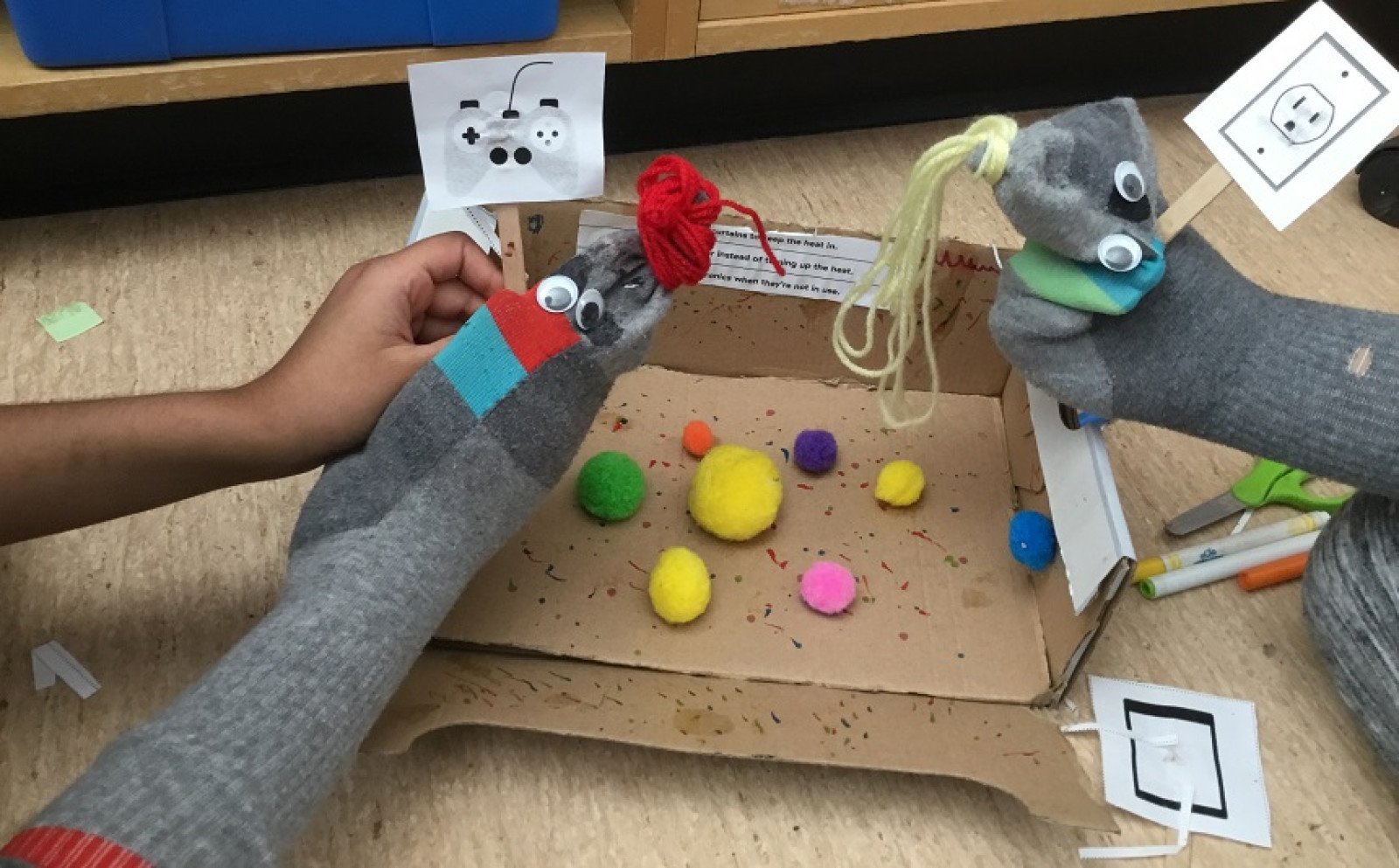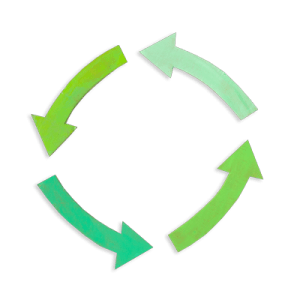Energy-saving puppet show
Take action saving energy, design a puppet show and share your energy-saving tips.

Overview
Students get involved in discovering ways to save energy. They’ll make puppets and design a show to creatively share messages on how to save energy and help our planet.
Instructions
What you'll need
Action on energy
- "Puppet show" slideshow
- Projector, computer, screen for slideshow
Puppets share the message
- Craft supplies to make puppets and scenery for the puppet show:
- Items to decorate the puppets: markers, googly eyes, buttons, yarn, cotton balls
- Popsicle sticks
- Scissors
- Glue
- Cardboard box to form a stage
- "Puppet show scenery images" template
- Print one per group. Plan for 3-4 students per group. For younger students cut out the images
- Popsicle sticks
- Scissors
- Cardboard box to form puppet show stage
- "Energy-saving messages" template
- Print and cut out the scene messages. Plan for 3-4 students per group, print one set of scene messages per group
French versions of the slideshow and templates are also available.
Energy-saving tips
- Pull up the "Puppet show" slideshow.
- At slide 2 and 3, introduce climate change and explain that we can all do things that help protect the Earth and saving energy is one way.
- At slides 4 to 6, share that in B.C., most of our energy comes from water (hydroelectric dams), which is clean, renewable energy. However, if we waste this energy, we are wasting our natural resources. Natural resources come from the Earth like water, trees and fish. By saving energy we can protect our natural resources, and our Earth.
- At slide 7, explain to students that we’ll be exploring different ways to save energy.
- At slide 8, ask students to think of ways we use energy in our homes, and how we can save energy. Prompt the students to consider the different rooms in their home. In the kitchen we can save energy by closing the fridge door, turning off lights, and using a toaster oven instead of the stove oven. In the living room we can save energy by turning down the heat and using a blanket or sweater, having a family board game night instead of watching TV and unplugging electronics at night. In the bathroom / laundry we can save energy by taking shorter showers, as heating water uses energy, washing clothes in cold water and hanging clothes to dry.
- At slide 9 to 12, we reveal some of our ideas. Did your students think of more?
- At slide 13, ask students to think of ways we use energy getting to school, and how we can save energy. Transportation can use a lot of energy; can we make better travel choices other than by car? Ask students to list all the ways we can get to school using people power like biking, walking, scooting, skate boarding and running. If students live far from school ask them to think of ways to get to school like bussing or car-pooling.
- At slide 14 to 15 we reveal some of our ideas. Did your students think of more?
- At slide 16, ask students to think of ways we use energy at school, and how we can save energy. Have students look around the classroom and see what uses energy like lights, projector, and computers. Remember to power down and unplug after this slide show is finished.
- At slide 17 to 19 we reveal some of our ideas. Did your students think of more?
Puppets share the message
- At slide 20, explain to students that they’ll be making puppets and creating a puppet show to teach other students how to save energy. Slide 21 shows our sock puppets with a light scenery prop.
- Divide students into groups of 3 to 4 students per group and provide each group with supplies to make a puppet. Students can each have a used sock to create their puppet and make them into speaking characters for the show. Use googly eyes, buttons, yarn, cotton balls or other art supplies and recycled materials you have in your classroom. Set aside and allow time for the glue to dry.
- Next, provide each group with a scene for their puppet show. Options could be kitchen, living room/classroom, bathroom/laundry room, or the outdoors.
- Provide each group with a copy of “Puppet show scenery images” template. Students can choose the images that fit the scene for their show. These images can be glued on to the popsicle sticks. Alternatively students can make their own images.
- Have each group create the stage for the puppet show. Use a cardboard box to form the stage and decorate with paint or markers or by adding fabric to make the stage curtains.
- Students then design their puppet show incorporating ways they can save energy in their scene. The energy-saving tips from the “Energy-saving messages” template can be used to help the students design their script and are divided into the different scenes.
- Depending on the reading skills of your class, you may want to read them to the groups to select one or more messages for their puppet show.
- Students then practice their puppet show making sure to include energy-saving tips. Students can take turns sometimes being the speaking puppet and sometimes holding the scenery popsicle sticks.
- Once prepared, groups can take turns performing their puppet show for the class.
- After each puppet show return to the slide show at slide 22 and view questions to ask class
- What was the energy-saving tip you learned from this puppet show?
- What is one thing you liked about the puppet show?
- At slide 23, complete the activity by asking the students:
- What are some things we learned about how to save energy?
- What can we do when we go home today?
- How can we help ourselves and our families remember these ideas?
Modify or extend this activity
- To encourage idea generation, give students 1-2 minutes to brainstorm in pairs before sharing with the class.
- Students could perform the puppet shows for other students in the school.
Curriculum Fit
Our activities provide a link to the core competencies of the curriculum. The activities engage students in sharing ideas and solutions, having fun learning and teaching others through creative thinking and making.
Core competencies:
Communications
- Connect and engage with others (to share and develop ideas)
- Collaborate to plan, carry out, and review constructions and activities
Thinking
- Creative thinking: novelty and value
- Critical thinking: develop and design
Social responsibility
- Contributing to community and caring for the environment
Grade K-3 Applied Design, Skills and Technologies
Big ideas
- Skills can be developed through play
Grade 2, 3 Science
Content
- Water conservation (Grade 2)
- Sources of thermal energy (Grade 3)
- Transfer of thermal energy (Grade 3)
Grade K-3 Arts Education
Content
- Drama: character, time, place, plot
- Visual arts: elements of design: line, shape, texture, colour; principles of design: pattern, repetition
Curricular competencies
Communicating and documenting
- Express feelings, ideas, stories, observations, and experiences through the arts
Assessments
- Assess students’ understanding and ways they can save energy.
- Assess students’ understanding of the energy-saving message in their puppet show.
- Assess students’ ability to communicate their energy message to the class.
- Assess the audiences’ ability to watch the puppet shows and learn something about energy-saving.
Teaching Notes
Clean energy powered by water
BC Hydro uses the power of falling water to create clean, reliable electricity. BC Hydro generates/produces 97% clean energy.
However conservation of electricity in B.C. is an important message since wasting energy also wastes our Earth’s resources. Young people can protect and care for our environment. We can empower them by helping them understand ways to save energy and in a fun, creative way, share this knowledge with others.
The following are some energy-saving tips:
- Turn off unnecessary lights, and/or switch to LED’s, which reduce energy use by 75% compared to incandescent lights.
- Take shorter showers and switch to a low flow showerhead. A low flow showerhead uses nearly half the water / minute of a regular showerhead. This reduces both water and energy.
- Turn the water off when washing hands and brushing teeth. Leaving the water running can waste 10 litres of water per minute.
- Fix leaky faucets, as a dripping tap can pour 150 litres of water down the drain in one week.
- Unplug unused electronics. Standby power can account for 10% of an average household's annual electricity use.
- Install and manage a thermostat. Programming to lower your heating at night and when you are out can save a lot of energy.
- Be strategic with window coverings. Closing curtains and blinds at night can keep the heat in.
- Wash laundry in cold water, run full loads and hang it out to dry. This will save energy and your clothes will last longer.
- If you are using a dryer, toss a dry towel in too. This will significantly reduce drying times.
- Use the microwave, crock pot or toaster oven instead of an oven to save energy.
See BC Hydro energy-saving tips for additional tips and cost savings.







